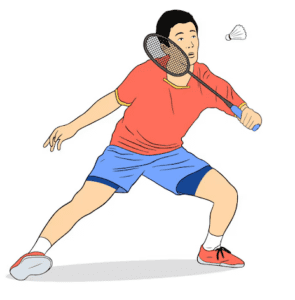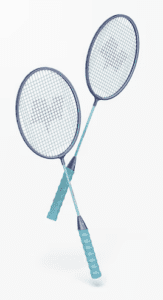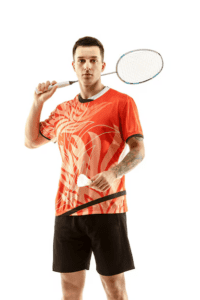Badminton is a fun and very healthy game. Mastering it will give you an opportunity to exercise while having fun at the same time. It’s an excellent form of cardio which helps in muscle growth and muscle stretching.
But to master it, you first need to select the ideal badminton for yourself. Without selecting a good badminton player, you might end up fatiguing yourself. It’s a relatively easy game but can be daunting if your racket is not ideal.
In this article, we will discuss how to choose the best badminton racket for beginners. By beginner, we mean someone who is just starting out and doesn’t have the proper hand coordination. Our suggestions and recommendations will be based on this skill level.
So without any further wait, let’s get started with the things that will help you to choose the best racket.
How do I choose my first badminton racket?
A lot of factors go into choosing the ideal racket for beginners. You will have to consider things like your hand flexibility, racket flexibility, string tension, material, and a lot more.
Another thing that plays a huge role in selecting the right one is considering your playstyle. Some people like to play aggressively with powerful strokes.
Others like to play in a defensive mode where they can flexibly and effortlessly move around and counter the opponent’s strikes. And then some people are neutral and want a racket that can perform well in both of these situations.
If you are just starting out and looking to buy a new racket, we recommend researching a bit more. You should first consider which playstyle you love the most. You can watch other players and see their tactics and playstyle. You should also watch professional players with different playstyles and capabilities. Once you are sure which playstyle you are passionate about, then you can confidently make the best decision to buy the first racket.
How do I know my badminton racket size?
Size matters! Especially in badminton. Now we are not talking about the overall size of the racket. They are generally of the same size and don’t have a huge impact on the performance. What really matters here is the grip size of the racket. The grip can make or break your game. You will be holding on to that grip for the entirety of your training sessions and games. Selecting the right grip for your racket is crucial.
 People with bigger hands will require a bigger grip and vice versa. Now the best way to determine the perfect size is by actually gripping it with your hand. But you won’t be able to play with it in the shop, right? For that, You can try to get hands-on with some of your friend’s rackets. You will be able to instantly get a feel for it. Play a game or two to better feel the grip and consider how comfortable it is for you.
People with bigger hands will require a bigger grip and vice versa. Now the best way to determine the perfect size is by actually gripping it with your hand. But you won’t be able to play with it in the shop, right? For that, You can try to get hands-on with some of your friend’s rackets. You will be able to instantly get a feel for it. Play a game or two to better feel the grip and consider how comfortable it is for you.
If you don’t have a friend, you can always go with a smaller grip first. If you are an average-sized person, you should buy the smallest one. And if you are a huge person then you should go for a medium-sized grip. The reason for that is simple, which is that you can always add extra grip-on if you feel that it’s a small size. On the other hand, if you buy a racket with a bigger grip, the only two options you will have is to either ask the shop owner to replace it or trim the sides down (which we highly don’t recommend). Or if you can afford an expensive racket, you can go for a racket with a customized handle.
Make sure that your fingers are not overlapping each other once you grab the racket. Nor are they far away which causes discomfort and a loosened grip on the handle.
Is head heavy or head light better for beginners?
When asked how to choose the best badminton racket for beginners, one of the most common follow-up questions people have is about the weight of the heads. As you are new, you probably don’t know the difference between head heavy and head light racket. These are some technical terms used to describe a very simple yet important aspect of badminton.
A head-heavy racket means that the front part of the racket is heavier than the gripping side of the racket. On the other hand, a headlight racket is lighter on the front (striking side) and heavy on the back from where you grip the racket. These two are ideal for heavy striking and easy maneuverability, respectively. It’s simple physics.
The head-heavy racket will be difficult to maneuver as all the weight is in the front. Just like the weight is divided in a hammer. You will find it difficult to move and strike. But what’s the benefit? The same benefit that you get in a hammer due to increased lever action.  You will be able to generate more force and strike with more power.
You will be able to generate more force and strike with more power.
The head-light racket is heavier at the gripping side which provides a stable base. It provides flexibility and you will be able to move around easily.
As you are just starting out, we recommend going with the headlight racket, even if you like the aggressive playstyle. The reason for this is that you will learn more by using a light racket. You will be able to play shots from different angles, something that is difficult in a head-heavy racket. You can always build more strength over time once you have mastered the basics. Now if you are someone with strong genetics and strength and feel the heavy-head is a light one, then you can go for the heavy one.
Which racket is better: Carbon or Graphite?
Carbon rackets vs Graphite rackets, the never-ending debate in the world of badminton. You will often find people discussing and debating with each other on the benefits of each of these materials. Let us clear up all the confusion here as it’s very simple.
Graphite is the preferred material of most people and manufacturers. It provides strength, durability, and most of all flexibility. This flexibility allows the manufacturers to be creative and come up with better designs to enhance the comfortability and performance of the racket. This is also a cheaper option compared to the carbon fiber ones. These are best suited if you have to train for long hours as you can get a new one in case you break it by hitting it on a side or the ground.
On the other hand, a carbon fiber racket is more expensive and is rarer. These rackets are very strong and provide unmatched frame strength. This allows the players to tighten the strings to the fullest without breaking the frames. This is something that you cannot do with other racket materials. This is something that we will also be discussing in detail. But as a beginner, we recommend you not invest a lot in the carbon fiber racket. Start with graphite and once you get more experience, you can make an informed decision on buying the carbon one.
How do you choose badminton string and tension?
Now this is a technical thing. We want you to understand the role of string and how the string tension affects the power a racket generates.
All the strings in the world, the strings of your badminton will also start to lose with time. So, more tension means that it might stay tight for longer.
In terms of power, strings with more tension create more power. Every racket has a sweet spot. This sweet spot generates the most power. A loose string increases the surface area of this sweet spot, which gives consistent shots with reasonable strength. This is ideal for beginners as they find it hard to hit the sweet spot.
More tensed strings with more power generation capability are used by experienced people and professionals. More tension allows you to generate more power but as a beginner, you won’t be able to hit the sweet spot consistently. Another downside of using high tension in the start is that it will shorten the lifespan of your racket. Each time you miss the sweet spot, the strings will lose their strength and soon you will find yourself replacing the strings or your racket.
Don’t just focus on generating the maximum force with your racket. Once you master the basics with light strokes, you will easily be able to transfer those skills to a more powerful and aggressive playstyle. Start by using a light-head racket with normal tension in the springs.





